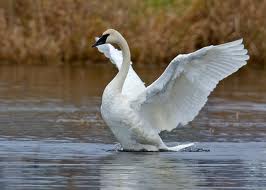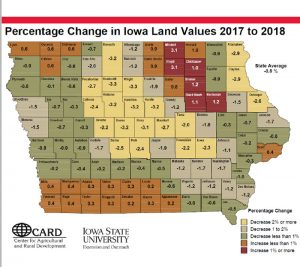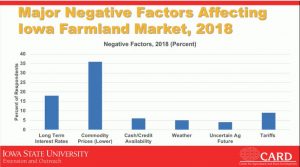CLICK HERE for the latest market quotes from the Iowa Agribusiness Network!
CLICK HERE for the latest market quotes from the Brownfield Ag News Network!
CLICK HERE for the latest market quotes from the Iowa Agribusiness Network!
CLICK HERE for the latest market quotes from the Brownfield Ag News Network!
You’re invited to join Cass County Conservation Staff at the Schildberg Recreation Area- Lake #4, on Saturday, January 5th, 2019 for the annual “Soiree with the Swans.” Conservation Staff will be giving ten-minute presentations regarding the Trumpeter Swans every half-hour beginning at 11:00 a.m., with the last one being presented at 2:00 p.m. There will also be time to view the swans through spotting scopes and witness random swan feeding sessions. Hot chocolate, cookies, grilled hotdogs, and other snacks will be provided free of charge with donations being accepted (for swan care). 
The Schildberg Recreation Area is located on the northwest edge of Atlantic, Lake 4 is on the north side of Highway 83. IF THE WEATHER IS “BAD” OR THE SWANS ARE NOT AT THE PARK…the program will be held at the Atlantic Public Library Jan/ 5th, from 12:00 p.m.-1:00 p.m. with a light lunch available. The event is being sponsored by the Cass County Conservation Board, Atlantic Parks and Recreation, the Iowa Department of Natural Resources, and the Atlantic Public Library.
Guthrie Center, Iowa – Registration is now open for the Feb. 8-10 Beyond BOW (Becoming an Outdoors Woman) workshop in Guthrie County. The two-day, hands-on workshop headquartered at Springbrook State Park, near Guthrie Center, is an opportunity to learn to ice fish, winter survival skills, how to snowshoe and cross country ski and more. Evening sessions and overnight lodging will be at nearby Firefly Creek Ranch at 2345 Redwood Ave, Guthrie Center. The Iowa Department of Natural Resources and the Shelby and Pottawattamie County Conservation boards are partnering to offer this program.
Workshop fees include instruction/training, program materials and equipment, meals and lodging (if selected). Various workshop and lodging options are available. Registration is available at https://www.iowadnr.gov/bow. Attendees should plan to eat prior to arriving Friday. Participants will need to a valid fishing license for the ice fishing course before the workshop.
Beyond BOW is a continuation of the popular Becoming an Outdoors Woman (BOW) workshop, that focuses on teaching outdoor skills to women 18 years or older. However, the workshop is open to anyone, regardless of gender.
(Radio Iowa) — Licenses are now on sale for the paddlefish season on the Missouri and Big Sioux rivers. The D-N-R fisheries expert for the area, Chris Larson says there are a couple of options for getting a license. You can purchase one tag now through December 31st. There are 950 resident or 50 non-resident licenses and if there are any left over you can purchase a second tag from January 1st through January 7th. A resident license sells for 25 dollars and 50 cents and a nonresident license is 49 dollars. You must also have a valid Iowa fishing license. Larson says there usually are enough licenses for everyone who wants one. “The first year we sold almost 800 of the thousand that are available — but the last couple of years we’ve sold right around 400. You should be able to get one — obviously there’s no guarantee — but we have not sold out since we started the season in 2015,” according to Larson.
Paddlefish are caught by snagging them as they swim on the bottom of the river. He says they’ve made some changes to try and get more people interested. One change involves the rules that required you to throw back any rough fish you snagged while trying to get a paddlefish. “Anglers were upset about that and they also wanted a longer season,” Larson says. “So, we open the season earlier, its going to open February second through the 30th of April, which is an earlier start than when we started the season five years ago. You can also snag rough fish and keep those as well. So if you want some common carp or Asian carp for table fare,” he explains. It’s the second year for the adjustments that are aimed at bringing back those who tried paddlefishing and didn’t stay with it. He says hopefully the people who were upset about not keeping the rough fish will come back out.
Larson says you have to be specific in where you are looking for the paddlefish. He says the fish in the winter will be found in the slow-moving deep water and the only place you can find that is the holes behind the wing dikes where the fish overwinter. You a limited to catching one fish when you purchase a paddlefish tag. “You have to put the tag on the jaw — and as soon as you are out of tags you have to stop snagging. If you only have one tag and you snag a paddlefish and you are going to harvest it, you are done. You can also continue to snag the paddlefish and release them as well,” Larson says.
You can find out more about the paddlefish season by going to the Iowa Department of Natural Resources website at: www.iowadnr.gov.
The Cass County Board of Supervisors, Monday, passed a Resolution pertaining to the construction of livestock feeding operations.
The “Construction evaluation resolution,” or, “Master Matrix” as it’s commonly called, permits those counties that have adopted the Resolution to submit to the Department of Natural Resources (DNR), an adopted recommendation to approve or disapprove a construction permit application regarding a proposed confinement feeding operation structure, and the ability to contest the DNR’s decision regarding such matters, if a specific construction application approved by the Board, is denied by the DNR.
The Resolution is acted upon annually by the Cass County Supervisors, and covers those applications received, evaluated and scored by the Board between February 1, 2019 and January 31, 2020.
Prior to the start of their regular session Monday afternoon, the Supervisors conducted a canvass of the Dec. 11, 2018 Iowa Western Community College Bond vote.
Their next regular meeting takes place Monday, Dec. 31st, unless an urgent matter requires their attention and action.
BISMARCK, N.D. (AP) — The resumption of soybean sales to China this week is encouraging to American farmers who have seen the value of their crop plummet amid a trade war with the world’s second-largest economy, but producers see it only as a small step and say they need more federal aid.
Private exporters reported sales of 1.13 million metric tons of soybeans to China on Thursday and another 300,000 metric tons on Friday, the U.S. Department of Agriculture said. The Thursday report was the ninth-largest daily sale since 1977, according to the agency’s Foreign Agriculture Service, and it comes less than two weeks after the Trump administration reached a three-month truce in its trade war with China during which the two sides will try to work out their differences.
Davie Stephens, a Kentucky farmer who serves as president of the American Soybean Association, said the resumption of sales is “positive news” but that “it is vital that this 90-day process result in lifting the current 25 percent tariff that China continues to impose on U.S. soybean imports.”
China had suspended U.S. soybean purchases earlier this year but under the truce agreed to buy more U.S. farm products. The country typically buys between 30 million and 35 million metric tons of U.S. beans in a normal year. News of the U.S. sale might prompt some farmers to sell some of the soybeans they have stored on their farms, in part because South American crops will be hitting the world market within a couple of months, said Huron, South Dakota, farmer Brandon Wipf, who serves on the American Soybean Association board.
Soybean farmers are getting the largest share of a federal program created to compensate producers up to $12 billion for trade-related losses, though this year’s payment of 82 cents a bushel doesn’t match a market price drop of about $2 per bushel since May. The Trump administration has said another 82 cents might be approved next year if a trade deal isn’t reached. Both the American Soybean Association and the National Farmers Union this week pushed for a second payment while the administration works on a long-term trade solution.
North Dakota U.S. Sen. John Hoeven, chairman of the Senate Agriculture Appropriations Committee, said Friday that he stressed the importance of the second payment to Office of Management and Budget Director Mick Mulvaney. Not getting a second payment could be a “deal-breaker” for some farmers in terms of their support for the Trump administration, according to Wipf.
“They would see that as a broken promise by the administration,” he said. “We’re of course encouraging the administration not to make the miscalculation that this little bit of detente we have with China has suddenly fixed all the problems we have.”
ESTHERVILLE, Iowa (AP) — Eight northwest Iowa families are fighting a company they blame for not doing enough to address the smell of dead, rotting hogs from a nearby rendering plant. The Des Moines Register reports that an attorney for the Estherville families filed a motion this week pushing for Emmet County leaders to take stronger action against Central Bi-Products, a Minnesota-based company.
The families say the county isn’t doing enough to ensure the problem gets fixed after three years of “extremely noxious, highly objectionable odors.”
The families’ attorney filed a motion to intervene in an Emmet County petition that seeks $4,750 from Farmers Union Industries, the parent of Central Bi-Products, for violating its conditional-use permit. The plant’s owner has said it’s making improvements that should reduce the odor.
(Radio Iowa) — A top U-S-D-A official suggests President Trump will have to referee a dispute within his administration about federal payments to partially cover farm losses due to the trade war. U-S Deputy Secretary of Agriculture Stephen Censky was in Iowa yesterday (Thursday), meeting with commodity group representatives. A SECOND round of direct payments to farmers was discussed. “We have been having a little bit of a disagreement with a few others, our budget office within the government — our Office of Management and the Budget,” he said. “Of course, their job is to control spending and to say, ‘No.’ We’re saying that the need is there. The circumstances haven’t changed and so Secretary Perdue plans on visiting and taking the issue to the president.”
This summer, the Trump Administration announced 12 billion dollars in federal aid would compensate farmers who Censky says have been “at the tip of the spear” when it comes to retaliatory tariffs. This fall, four-point-seven billion dollars’ worth of checks were sent to eligible farmers who had completed their harvest. Censky says trade disputes are still causing financial harm on the farm and it’s time to release another six BILLION in payments. “We know that farmers are going to be starting to visit with their bankers to talk about financing for next year coming up either now or right after the first of the year,” Censky said, “and so the time is now to make that announcement and get those payments made.”
China purchased a million ton of U.S. soybeans this week, but Censky is making it clear the U-S-D-A does not consider that the end of trade woes for farmers. “That’s a drop in the bucket compared to the 30 to 35 tons that we regularly export to them and so even if we see some very much robust purchases well beyond the million tons, farmers have still been impacted,” Censky says. Censky grew up on a corn and soybean farm in Minnesota and served two decades as C-E-O of the American Soybean Association. He delivered the keynote address Thursday, at the Iowa Soybean Association’s annual policy conference.
(Radio Iowa) — The new Iowa State University Land Value Survey released today (Wednesday) shows a small drop in land values. Iowa State University economist Wendong Zhang says values dropped just under one percent (.08). He says that puts the average values of an acre of land in the state at to seven-thousand-264 dollars. That’s 62 dollars an acre less than last year’s survey. Zhang says farmland prices peaked in 2013 at a just above 87-hundred dollars an acre ($8.716).
“For the last five years we have seen four declines — despite last year in 2017 there was a two percent increase — we have seen a steady decline off the peak,” Zhang says. Zhang says he has been asked repeatedly in the last five years if there is a concern about another collapse in values like we saw in the 1980’s. He says he is not concerned. “Overall I think the key message from this survey is ‘yes we are seeing downward pressure we are seeing a modest pressure, but overall we are seeing stabilizing land markets,” Zhang says. “There is no sign of sudden collapse. Overall, when you are looking at the district and county line changes — the county that declined the most only declined by about three percent
Humboldt and Wright Counties reported the largest percentage decrease in value at three-point-three percent. Zhang says there has been a drop in farm income that’s led to the drop in land values brought on in part by big crops. He says we’ve seen the six and seventh largest crops in the last six or seven years and he says there’s also been a rebound in the beef and pork markets, as well as an increase in pork processing. Zhang says the cost of money is another issue driving land prices.
“The second largest factor that people mention is a higher interest rate,” according to Zhang. “Over the last year, over the last three years actually, the Federal Reserve has been raising the interest rates.” He says the trade wars have also played some role. “The impacts of the tariffs on the economy is felt more by the agricultural states like Iowa,” Zhang explains. He expects land values to see another small dip next year — as he says new tariffs and other factors take some time before they are felt in land values.
“Typically its an income decline last year that affects this year’s land values. So it takes some time for the land markets to fully capitalize what’s happening in commodity prices…and the Federal Reserve interest rate hikes are a key factor in this,” Zhang says. Zhang says a trade deal with China could have some impact. “If you look at the commodity markets, just the sign that the two sides are talking gave a 50 cent bump in the commodity futures market,” Zhang says. He says that bump eventually went back down, but he says it shows the impact potential that is there.
Scott and Decatur counties held onto the highest and lowest farmland value spots for the sixth straight year. Decatur County had a value of three-thousand-488 dollars ($3,488) an acre. That’s an increase of eight dollars. Scott County reported a value of ten-thousand-537 ($10,537) dollars, which was an increase of 40 dollars an acre. The south-central district reported the largest percentage increase of three-point-eight (3.8) percent. The central and southeast districts reported decreases of two-point-four (2.4) percent and three-point-six (3.6) percent, respectively. The northeast and southwest districts reported no notable change in value.